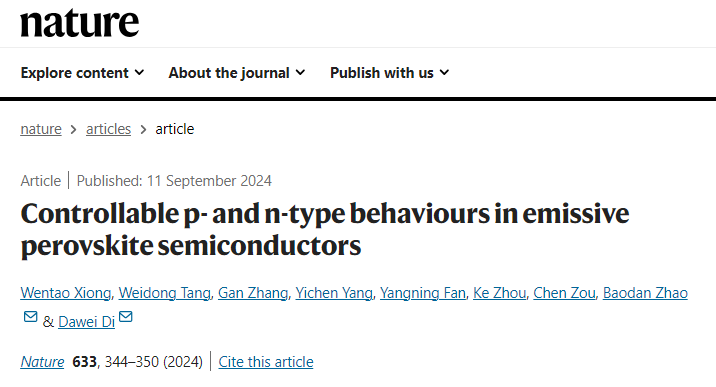On September 11, 2024, the paper was published in the top international academic journal 《Nature》 with the title of “Controllable p- and n-type behaviours in emissive perovskite semiconductors”. Corresponding authors are Professor David Di and Researcher Baodan Zhao from College of Optical Science and Engineering/International Campus, Zhejiang University, and the first author is Xiong Wentao, a 2020 PhD student from Zhejiang University.
Reliable control of the conductivity and its polarity in semiconductors is at the heart of modern electronics, and has led to key inventions including diodes, transistors, solar cells, photodetectors, light-emitting diodes and semiconductor lasers. For archetypal semiconductors such as Si and GaN, positive (p)- and negative (n)-type conductivities are achieved through the doping of electron-accepting and electron-donating elements into the crystal lattices, respectively. For halide perovskites, which are an emerging class of semiconductors, mechanisms for reliably controlling charge conduction behaviours while maintaining high optoelectronic qualities are yet to be discovered.
The paper report that the p- and n-type characteristics in a wide-bandgap perovskite semiconductor can be adjusted by incorporating a phosphonic acid molecular dopant with strong electron-withdrawing abilities. The resultant carrier concentrations were more than 1013 cm−3 for the p- and n-type samples, with Hall coefficients ranging from −0.5 m3 C−1 (n-type) to 0.6 m3 C−1 (p-type). A shift of the Fermi level across the bandgap was observed. Importantly, the transition from n- to p-type conductivity was achieved while retaining high photoluminescence quantum yields of 70–85%. The controllable doping in the emissive perovskite semiconductor enabled the demonstration of ultrahigh brightness (more than 1.1 × 106 cd m−2) and exceptional external quantum efficiency (28.4%) in perovskite light-emitting diodes with a simple architecture.






